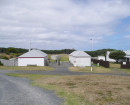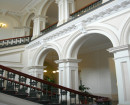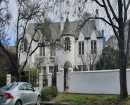TERRACE
100 PATERSON STREET PRINCES HILL, YARRA CITY
-
Add to tour
You must log in to do that.
-
Share
-
Shortlist place
You must log in to do that.
- Download report





Statement of Significance
The Terrace at 100-118 Paterson Street Carlton North consists of ten houses. The houses were erected on a speculative basis by Jurtus Wombach. Nos. 102-118 were constructed gradually from 1889-1894, although it appears that No. 100 was added in 1911. The single storey brick terrace has a gallery on the street facade with a cast iron frieze. The cornice and parapet are rendered and each house is expressed by a pedimented name plate.
The Terrace at 100-118 Paterson Street Carlton North is of architectural and historical significance to the State of Victoria.
The Terrace at 100-118 Paterson Street Carlton North is of architectural significance as a notable example of boom style terrace architecture. The unusually long row is composed of ten repetitive units with some variation in the parapets. The polychrome brickwork on the ground floor, the rendered cornice and parapet and the cast iron gallery comprise a typical boom period composition. The cast iron palisade railing between the front gallery and footbath is an original feature of the terrace.
The Terrace at 100-118 Paterson Street Carlton North is of historical significance as an essential part of the Carlton North precinct, an area that contains some of Melbourne’s finest and most intact 19th century streetscapes. The Terrace also provides evidence of the substantial growth of Melbourne’s inner suburbs in the latter decades of the 19th century. The extended period of construction of the individual houses probably reflects the nature of speculative building, although the intervention of the economic recession in the 1890s may have had some impact on their completion.
-
-
TERRACE - History
Associated People: Tenant WONBACH FAMILY;TERRACE - Permit Exemptions
General Exemptions:General exemptions apply to all places and objects included in the Victorian Heritage Register (VHR). General exemptions have been designed to allow everyday activities, maintenance and changes to your property, which don’t harm its cultural heritage significance, to proceed without the need to obtain approvals under the Heritage Act 2017.Places of worship: In some circumstances, you can alter a place of worship to accommodate religious practices without a permit, but you must notify the Executive Director of Heritage Victoria before you start the works or activities at least 20 business days before the works or activities are to commence.Subdivision/consolidation: Permit exemptions exist for some subdivisions and consolidations. If the subdivision or consolidation is in accordance with a planning permit granted under Part 4 of the Planning and Environment Act 1987 and the application for the planning permit was referred to the Executive Director of Heritage Victoria as a determining referral authority, a permit is not required.Specific exemptions may also apply to your registered place or object. If applicable, these are listed below. Specific exemptions are tailored to the conservation and management needs of an individual registered place or object and set out works and activities that are exempt from the requirements of a permit. Specific exemptions prevail if they conflict with general exemptions. Find out more about heritage permit exemptions here.
-
-
-
-
-
COTTAGE
 Victorian Heritage Register H0594
Victorian Heritage Register H0594 -
IRON HOUSE
 Victorian Heritage Register H0665
Victorian Heritage Register H0665 -
TERRACE
 Victorian Heritage Register H0078
Victorian Heritage Register H0078
-
"1890"
 Yarra City
Yarra City -
"AMF Officers" Shed
 Moorabool Shire
Moorabool Shire -
"AQUA PROFONDA" SIGN, FITZROY POOL
 Victorian Heritage Register H1687
Victorian Heritage Register H1687
-
'NORWAY'
 Boroondara City
Boroondara City -
1 Mitchell Street
 Yarra City
Yarra City
-
-















